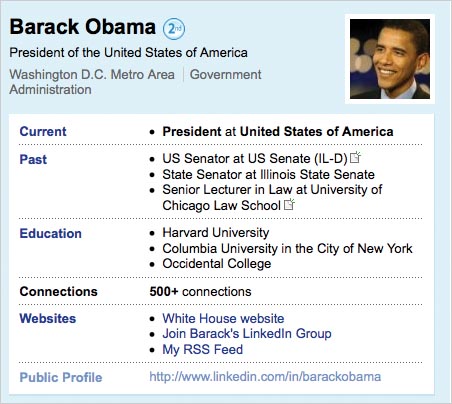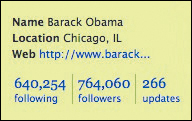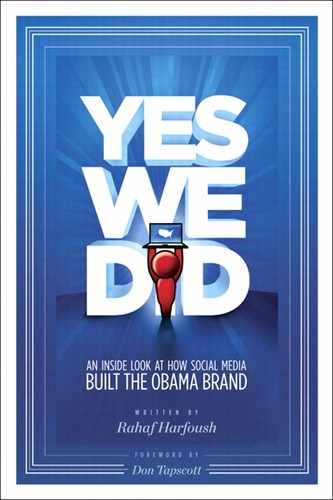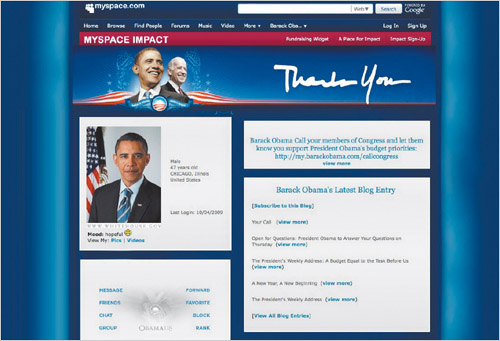11. Social Networks
OBAMA EVERYWHERE
THE CAMPAIGN USED SOCIAL NETWORK SITES to increase their messaging reach and create relationships with supporters outside of MyBO. Barack Obama recognized the opportunity to connect with specific demographics and was the first candidate to build profiles on social networks that targeted minority communities, including MiGente, BlackPlanet, FaithBase, and AsianAve. The idea was to bring the campaign into the online communities where voters were already spending time. “Some people only go to MySpace. It’s where they’re on all day. Some only go to LinkedIn. Our goal is to make sure that each supporter online, regardless of where they are, has a connection with Obama,” said Scott Goodstein, Director of External Online Organizing. Goodstein’s team monitored and maintained Obama’s social network profiles. “Then, as much as we can, we try to drive everyone to our site.”
A profile on a particular social network could emphasize content that resonated with that particular audience. For example, in his FaithBase profile, Obama focused on the value he derived from his own faith. On GLEE, an online community for Gays, Lesbians, and Everyone Else, Obama highlighted his efforts to promote and support equality. From a more practical perspective, the campaign invited Flickr users to share their images of the campaign, knowing that the pictures would be of higher quality because the community is geared to photography enthusiasts and professionals.
“When it came to MySpace, we decided to take a leap. We decided to make the attempt to combine the organic support and community-building of a grassroots effort with the official campaign outreach efforts.”
—Joe Rospars, May 2, 2007
The campaign demonstrated a nuanced understanding of almost every social networking platform. From MySpace’s push for unique profile pages, to LinkedIn’s network of small business owners, the campaign engaged with these sites accordingly, providing high-value services and features to their supporters. In this chapter we will examine the strategies employed by the campaign at four major social networks: Facebook, MySpace, LinkedIn, and Twitter.

The campaign’s Facebook presence included official profiles for Barack, Michelle, and Joe as well as ten additional profiles targeting specific demographics, such as Veterans for Obama, Women for Obama, and African Americans for Obama.
In another technological first, in March 2007 the Obama new media team developed an innovative Facebook application that harnessed the power of interactive data. This linked a user’s MyBO account with their Facebook account, seamlessly importing their Facebook contacts into MyBO and publishing their MyBO activities onto Facebook’s newsfeed. The Obama Facebook application allowed the campaign to transform each community member’s list of family and friends into an audience for campaign activities. When a MyBO user updated his or her fundraising status or joined a group, that information was published to all their Facebook friends, creating awareness about campaign issues and even luring a few curious folks to MyBO for more information.
The small widget was added to a user’s Facebook profile page, and contained a stream of the campaign’s most recent videos and the latest news items. Users were not directed to an external site but could access the content immediately from Facebook and they could rate and comment on videos. Because it received high user rankings, Obama’s campaign content became available to a supporter’s extended social network and offered more campaign content and links to the Obama site such as MyBO and the official blog. With the click of a button, supporters could select specific friends or family members they wanted to share Obama content with: digital word of mouth. Because online organizing equals offline action, the widget identified all contacts who lived in the early primary/caucus states, and urged supporters to encourage their friends to vote.
The campaign turned the application into a digital yard sign, allowing users a new way to show their support.
MySpace
The campaign leveraged MySpace users’ ability to customize their profile pages by providing supporters with an array of widgets, banners, and buttons.
MySpace would also represent one of the first social network stumbles for the campaign, when the Obama team clashed with a user who had created an unofficial profile for Barack Obama before the campaign had created an official presence. Inspired by Obama’s 2004 Democratic National Convention address, Joe Anthony had created and maintained the MySpace profile for two years, and had built its base of contacts to thirty thousand online friends. Every day after working a full-time job, Anthony would patiently answer hundreds of messages from supporters and ensure that the site contained the most up-to-date information.
In early 2007, Chris Hughes, Obama’s Director of Online Organizing, contacted Anthony and the two made an arrangement to work together. In exchange for giving the campaign full access to the MySpace account, Anthony could continue to manage the site and would receive support from the campaign in the form of advice and access to content. The profile’s friends list grew to 100,000 and then skyrocketed to 140,000 after MySpace featured Obama’s profile.
By May 2007, Anthony workload grew to an unmanageable level, and he emailed the campaign asking for compensation. After some attempts at negotiation they were unable to reach an agreement and he changed the password and denied them access completely.
The loss of control of such an important online property was unacceptable for the new media team. “Every day, MySpace was driving tens of thousands of people to the page on the premise that this was more or less our ‘official’ presence—yet we had no access to the content on the page, and no ability to be responsive to the thousands of messages coming in from supporters seeking information or action from the campaign,” Joe Rospars wrote on the official blog in May 2007.
The campaign contacted MySpace, which gave the profile and URL myspace.com/barackobama to the campaign and allowed Anthony to transfer his contacts to another profile. Rospars acknowledged the less-than-ideal solution. “At the end of the day, this is all new for everyone,” he concluded in a blog post. “We’re flying by the seat of our pants, and establishing new ways of doing things every day. We’re going to try new things, and sometimes it’s going to work, and sometimes it’s not going to work. That’s the cost and that’s the risk of experimenting.”
Barack Obama did call Joe Anthony to thank him for his efforts, which Anthony described as “an honor.” Ultimately, this experience proved to be a valuable lesson for the campaign about the importance of securing official properties on social networks early on in the process, and about some of the implications of having an empowered and digitally savvy grassroots movement that feels ownership over the campaign. The Obama team’s transparency in clearing things up allowed them to emerge from this incident unscathed.
By understanding the different types of users who frequent various social networks, the campaign was also able to mine valuable information. For example, on LinkedIn, the campaign asked business professionals, “How can the next president better help small business and entrepreneurs thrive?” The campaign received over 1,500 answers, the most replies ever on LinkedIn. In addition, because members of the community were business owners, entrepreneurs, and professionals, the answers came from the very people that Obama’s economic policies would affect. Not only did this effort start a meaningful dialogue with small business owners, it was the equivalent of a large-scale, complex online focus group conducted at minimal cost to the campaign.


ON ELECTION DAY, Barack Obama had 115,000 followers on Twitter. As of March 2009, Obama is the most followed person on the microblogging site, with over 424,584 followers. Twitter allows users to share short snippets of their lives in 140-character messages, and was used by the campaign to update supporters on Obama’s whereabouts and election developments. Twitter updates, called tweets, contained links to live-streaming videos or new campaign ads. I found Twitter to be the most underutilized social network used by the campaign. Twitter is powered by conversations between users, and the campaign only broadcasted information instead of engaging users in dialogue.
![]()

